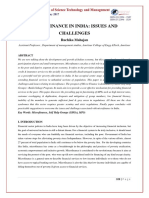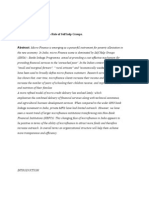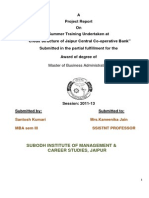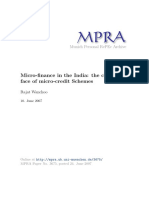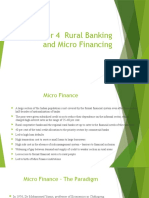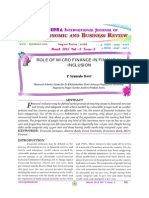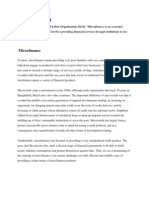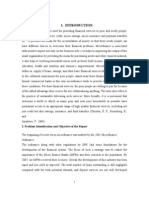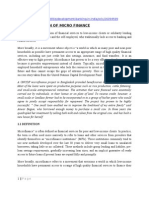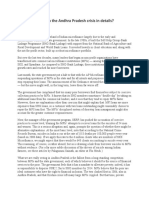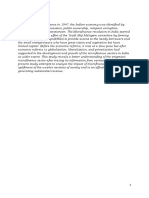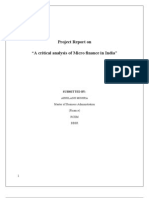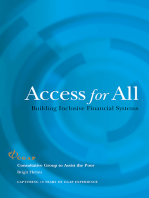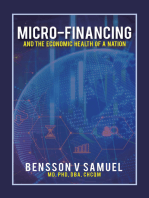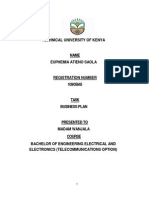The Scenario of Retail Industry in India: Its Growth, Challenges and Opportunities
The Scenario of Retail Industry in India: Its Growth, Challenges and Opportunities
Uploaded by
Sajja VamsidharCopyright:
Available Formats
The Scenario of Retail Industry in India: Its Growth, Challenges and Opportunities
The Scenario of Retail Industry in India: Its Growth, Challenges and Opportunities
Uploaded by
Sajja VamsidharOriginal Title
Copyright
Available Formats
Share this document
Did you find this document useful?
Is this content inappropriate?
Copyright:
Available Formats
The Scenario of Retail Industry in India: Its Growth, Challenges and Opportunities
The Scenario of Retail Industry in India: Its Growth, Challenges and Opportunities
Uploaded by
Sajja VamsidharCopyright:
Available Formats
The Scenario of Retail Industry in India: Its Growth, Challenges and Opportunities
Presented
By
* K.Chandra Sekhar
* * Shaik Gowsya
Abstract
Microfinance as the provision of thrift, saving, credit and financial services and products of very small amount to the poor in rural, semi-urban and urban areas for enabling them to raise their income levels and improve their standard of living. MFIs must be able to sustain themselves financially in order to continue pursuing their lofty objectives, through good financial performance. The present paper discusses conceptual framework of a microfinance institution in India. Key Words: Microfinance, Financial performance.
Introduction
Most poor people manage to mobilize resources to develop their enterprises and their dwellings slowly over time. Financial services could enable the poor to leverage their initiative, accelerating the process of building incomes, assets and economic security The lack of access to credit for the poor is attributable to practical difficulties arising from the discrepancy between the mode of operation followed by financial institutions and the economic characteristics and financing needs of low income households. Despite the success of microfinance institutions, only about2% of worlds roughly 500 million small entrepreneurs is estimated to have access to financial services
Strategic Issues Related to Micro-Finance
Is there a prevailing paradigm for micro-finance? Are there clearly visible pattern across the country? Is there clearly defined foundation building blocks such as organizing principles, gender preferences and operational imperatives? What are methodological issues?
Institutional Issues Related to Micro-Finance
Is there a need for a new institution? Should it operate all India or in a state? Where should it be located? Who can lead an institution of this sort? What will its contextual interconnections be? Who will be its beneficiaries?
Connectivity Issues Related to Micro-Finance
How should the Corporate Financial Sector be involved? What is the role of donor agencies? How should communities be involved? Are there political issues that should be explicitly considered? Are there government policy issues?
Micro-Finance Institutional credit and poverty alleviation
In India, institutional credit agencies (banks) made an entry in rural areas initially to provide an alternative to the rural money lenders who provided credit support, but not without exploiting the rural poor Their role in poverty alleviation was more appreciated when the Government, as a major paradigm shift, decided to launch a direct attack on poverty, through its special employment generation strategies and productive asset creation programs like Integrated Rural Development Program (IRDP). The micro-finance scene in India is dominated by Self Help Groups (SHGs) Banks linkage program for over a decade now. The SHG - Banks linkage program was conceived with the objectives of developing supplementary credit delivery services for the unreached poor, building mutual trust & confidence between the bankers and the poor and encouraging banking activity both on thrift as well as credit and sustaining a simple and formal mechanism of banking with the poor.
Community Driven Development Activities commonly taken up by the SHGs members:
Cleaning the village road, village pond and village school; To solve the drinking water problem, arrange a tube-well in the village; Helping to start a school for their own children and children of the village; Building a bridge over a small rivulet, thereby connecting the village road To the outside world. They did this by taking a contract from the local Authorities and using their own and other villagers free labour; Build a small patch of the village road;
Findings
Micro-Finance can be a powerful instrument initiating a cyclical process of growth and development. Micro-Finance activity improved access of rural poor to financial services, both savings and credit. Increased access signifies overcoming isolation of rural women in terms of their access to financial services and denial of credit due to absence of collateral. The pool of savings generated out of very small but regular contributions improved access of the poor women to bank loans. It could also help in strengthening poor families resistance to external shocks and reducing dependence on moneylenders.
Conclusion
First of all, the poor repay their loans and are willing to pay for higher interest rates than commercial banks provided that access to credit is provided. Secondly, the poor save and hence microfinance should provide both savings and loan facilities. Consumption loan is found to be especially important during the gestation period between commencing a new economic activity and deriving positive income. Careful research on demand for financing and savings behavior of the potential borrowers and their participation in determining the mix of multi-purpose loans are essential in making the concept work.
Thanking You
You might also like
- Bloodbank Project PresentationDocument27 pagesBloodbank Project PresentationSI AbirNo ratings yet
- Micro Finance (BankingDocument35 pagesMicro Finance (BankingAsim Waghu100% (1)
- Ignition ScriptingDocument152 pagesIgnition Scriptingvijikesh Arunagiri0% (1)
- CH Allen EgsDocument5 pagesCH Allen EgsY N S Y SNo ratings yet
- 05 Chapter-1 PDFDocument52 pages05 Chapter-1 PDFRohitNo ratings yet
- FSM AssignmentDocument50 pagesFSM AssignmentHardik PatelNo ratings yet
- MicrofinanceDocument2 pagesMicrofinancesangeetha subramanianNo ratings yet
- Research Paper Suhail Khakil 2010Document13 pagesResearch Paper Suhail Khakil 2010Khaki AudilNo ratings yet
- MicrofinanceDocument58 pagesMicrofinanceSamuel Davis100% (1)
- A Study On Role and Effects of Microfinance Banks in Rural Areas in India 1Document63 pagesA Study On Role and Effects of Microfinance Banks in Rural Areas in India 1Rohit KumarNo ratings yet
- A Study On Role and Effects of Microfinance Banks in Rural Areas in India 2Document55 pagesA Study On Role and Effects of Microfinance Banks in Rural Areas in India 2Rohit KumarNo ratings yet
- Micro-Finance in The India: The Changing Face of Micro-Credit SchemesDocument11 pagesMicro-Finance in The India: The Changing Face of Micro-Credit SchemesMahesh ChavanNo ratings yet
- Need For MF Gap DD and SSDocument2 pagesNeed For MF Gap DD and SSalviarpitaNo ratings yet
- Harika MicrofinanDocument16 pagesHarika MicrofinanMohmmed KhayyumNo ratings yet
- SMART PUSHNOTE - An Agent Based Intelligent Push Notification System 2017-18Document60 pagesSMART PUSHNOTE - An Agent Based Intelligent Push Notification System 2017-18sachin mohanNo ratings yet
- Edited MicrofinanceDocument59 pagesEdited Microfinancedarthvader005No ratings yet
- Chapter 4 Rural Banking and Micro Financing 1Document16 pagesChapter 4 Rural Banking and Micro Financing 1saloniNo ratings yet
- A Critical Analysis of Micro Finance in IndiaDocument54 pagesA Critical Analysis of Micro Finance in IndiaArchana MehraNo ratings yet
- MICROFINANCEDocument62 pagesMICROFINANCEHarshal SonalNo ratings yet
- FMI Final ReportDocument30 pagesFMI Final ReportVIDUSHINo ratings yet
- 7.P Syamala DeviDocument4 pages7.P Syamala DeviSachin SahooNo ratings yet
- IntroductionDocument10 pagesIntroductionhasan1046No ratings yet
- First and ForemostDocument7 pagesFirst and ForemostZakeyo Dala ChabingaNo ratings yet
- Problem Identification and Objective of The ReportDocument33 pagesProblem Identification and Objective of The ReportGhazal AijazNo ratings yet
- Report On Micro FinanceDocument54 pagesReport On Micro Financemohsinmalik07100% (1)
- Assignment of Financial InstitutionDocument9 pagesAssignment of Financial InstitutionKamalpreet_Mad_6500No ratings yet
- Micro Finance AssignmentDocument8 pagesMicro Finance Assignment19DM017 .SubhamNo ratings yet
- Statement of PurposeDocument5 pagesStatement of PurposeShalini SinghNo ratings yet
- Report On Micro FinanceDocument55 pagesReport On Micro FinanceSudeepti TanejaNo ratings yet
- Microfinance Chapter 1Document27 pagesMicrofinance Chapter 1Prakash KumarNo ratings yet
- Mfi Obj.1Document13 pagesMfi Obj.1Anjum MehtabNo ratings yet
- Assgnment On MFIDocument3 pagesAssgnment On MFINitin MehndirattaNo ratings yet
- Report On Micro FinanceDocument12 pagesReport On Micro FinanceNawaz GodilNo ratings yet
- Financial Inclusion & Financial Literacy: SBI InitiativesDocument5 pagesFinancial Inclusion & Financial Literacy: SBI Initiativesprashaant4uNo ratings yet
- 3B VillerozDocument10 pages3B VillerozTrixie Ros VillerozNo ratings yet
- Micro Finance AssDocument24 pagesMicro Finance Assanuradha9787No ratings yet
- A Brief On Microfinance: Patni InternalDocument4 pagesA Brief On Microfinance: Patni InternalshiprathereNo ratings yet
- Loans Savings Insurance TrainingDocument9 pagesLoans Savings Insurance TrainingMohammad Bilal ShahNo ratings yet
- Role of Microfinance Institution in Financial InclusionDocument15 pagesRole of Microfinance Institution in Financial Inclusionswati_agarwal67No ratings yet
- Status of Microfinance and Its Delivery Models in IndiaDocument13 pagesStatus of Microfinance and Its Delivery Models in IndiaSiva Sankari100% (1)
- Term Paper of Banking & Insurance: Topic: Micro Finance Development Overview and ChallengesDocument18 pagesTerm Paper of Banking & Insurance: Topic: Micro Finance Development Overview and ChallengesSumit SinghNo ratings yet
- SMFISF270412 - Strengthening Governance in Micro Finance Institutions (MFIs) - Some Random ThoughtsDocument17 pagesSMFISF270412 - Strengthening Governance in Micro Finance Institutions (MFIs) - Some Random ThoughtsKhushboo KarnNo ratings yet
- Microfinance Industry, Tremendously Improving The Lives of People in Rural AreasDocument4 pagesMicrofinance Industry, Tremendously Improving The Lives of People in Rural Areasmrun94No ratings yet
- The Future of Microfinance in IndiaDocument3 pagesThe Future of Microfinance in IndiaSurbhi AgarwalNo ratings yet
- Micro Finance Research Paper....Document14 pagesMicro Finance Research Paper....Anand ChaudharyNo ratings yet
- Seminar Presentation: Presented by - SatishDocument14 pagesSeminar Presentation: Presented by - SatishsatishmnjprNo ratings yet
- The Importance of Microcredit Programs in Sustainable DevelopmentDocument4 pagesThe Importance of Microcredit Programs in Sustainable DevelopmentSafdar IqbalNo ratings yet
- Role of Microfinance Institutions in Rural Development B.V.S.S. Subba Rao AbstractDocument13 pagesRole of Microfinance Institutions in Rural Development B.V.S.S. Subba Rao AbstractIndu GuptaNo ratings yet
- NavdeepDocument18 pagesNavdeepArshdeep SinghNo ratings yet
- Project Report On "A Critical Analysis of Micro Finance in India"Document55 pagesProject Report On "A Critical Analysis of Micro Finance in India"Om Prakash MishraNo ratings yet
- Ijmrd: A Study On Recent Trends and Problems in Using Micro Finance Services in IndiaDocument11 pagesIjmrd: A Study On Recent Trends and Problems in Using Micro Finance Services in IndiaRogil Jacob DanielNo ratings yet
- Submitted To: Submitted By: Ambuj Gupta Sangram Keshari Panigrahi 2k91/BFS/43Document36 pagesSubmitted To: Submitted By: Ambuj Gupta Sangram Keshari Panigrahi 2k91/BFS/43Sangram PanigrahiNo ratings yet
- Project On Micro FinanceDocument44 pagesProject On Micro Financeredrose_luv23o.in@yahoo.co.in88% (8)
- Self Help GroupsDocument12 pagesSelf Help GroupsunknownNo ratings yet
- Project Report On "A Critical Analysis of Micro Finance in India"Document36 pagesProject Report On "A Critical Analysis of Micro Finance in India"Sanjay ShahNo ratings yet
- Lack CollateralDocument4 pagesLack CollateralMudassir AliNo ratings yet
- 53 Microfinance Revolution and The Grameen Bank Experience in Bangladesh20190805-48922-1a68le6-With-Cover-Page-V2Document62 pages53 Microfinance Revolution and The Grameen Bank Experience in Bangladesh20190805-48922-1a68le6-With-Cover-Page-V2Hidayatullah GanieNo ratings yet
- The Functional Microfinance Bank: Strategies for SurvivalFrom EverandThe Functional Microfinance Bank: Strategies for SurvivalNo ratings yet
- Banking India: Accepting Deposits for the Purpose of LendingFrom EverandBanking India: Accepting Deposits for the Purpose of LendingNo ratings yet
- Micro-Financing and the Economic Health of a NationFrom EverandMicro-Financing and the Economic Health of a NationNo ratings yet
- Inclusive Business in Financing: Where Commercial Opportunity and Sustainability ConvergeFrom EverandInclusive Business in Financing: Where Commercial Opportunity and Sustainability ConvergeNo ratings yet
- NRL Scada PreDocument2 pagesNRL Scada Premmeskalkaji2No ratings yet
- đề cuối kì 2 (viẹtack)Document4 pagesđề cuối kì 2 (viẹtack)trannhi13052004No ratings yet
- Service Manual: Dishdrawer™ DishwasherDocument55 pagesService Manual: Dishdrawer™ DishwashermosheNo ratings yet
- Business PlanDocument36 pagesBusiness PlanArun NarayananNo ratings yet
- ViatorCheck PDFDocument23 pagesViatorCheck PDFazitaggNo ratings yet
- Adhoc Question Bank EC2050Document31 pagesAdhoc Question Bank EC2050Raja Pirian100% (3)
- PROJECT MANAGEMENT TemplateDocument6 pagesPROJECT MANAGEMENT TemplateKen ChanNo ratings yet
- Proposed Price Sheets V1 PDFDocument2 pagesProposed Price Sheets V1 PDFCTN2010No ratings yet
- JASO 4 Stroke Motorcycle Engine Oil Code List 2014Document35 pagesJASO 4 Stroke Motorcycle Engine Oil Code List 20146zjptk1okNo ratings yet
- Sustainable Use of Resources - Grade 9Document9 pagesSustainable Use of Resources - Grade 9Tina MoyeniNo ratings yet
- Acute PancreatitisDocument2 pagesAcute PancreatitisLanh TangcongNo ratings yet
- THESISDocument24 pagesTHESISWilson TanNo ratings yet
- Post Graduate Diploma in Textile ManagementDocument10 pagesPost Graduate Diploma in Textile ManagementsurajyellowkiteNo ratings yet
- ks1 Emoji Multiplication Mosaic Differentiated Activity SheetsDocument6 pagesks1 Emoji Multiplication Mosaic Differentiated Activity Sheetschristina szerengaNo ratings yet
- Surpresa para Ni KikoDocument20 pagesSurpresa para Ni KikoLara Montera100% (1)
- IEEE Transactions Power Apparatus and Systems, Vol. PAS-100, No. 2, February 1981Document8 pagesIEEE Transactions Power Apparatus and Systems, Vol. PAS-100, No. 2, February 1981Kevin Alexander Becerra SulcaNo ratings yet
- Entrep 12 Marketing MixDocument14 pagesEntrep 12 Marketing MixZyrichNo ratings yet
- Vaginal ItchingDocument2 pagesVaginal ItchingHervis Francisco FantiniNo ratings yet
- BQ MAGAZINE Jan 2016Document43 pagesBQ MAGAZINE Jan 2016mohamed ibrahimNo ratings yet
- Chemistry Mole Concept....Document242 pagesChemistry Mole Concept....ojilongNo ratings yet
- Irrigation Agronomy Training Manual 7: Crop Calendar, Intensity and Crop Rotation For Proposed CropsDocument14 pagesIrrigation Agronomy Training Manual 7: Crop Calendar, Intensity and Crop Rotation For Proposed CropsSewnet EshetuNo ratings yet
- CustomersDocument109 pagesCustomersOmar NoahNo ratings yet
- REOTEMP INSTRUMENTS Product Drawing Thermowell, (Limited Space) With: - Threaded Process Connection - Straight ShankDocument1 pageREOTEMP INSTRUMENTS Product Drawing Thermowell, (Limited Space) With: - Threaded Process Connection - Straight ShankInsertec LtdaNo ratings yet
- Math 266 Introduction To Calculus II Study GuideDocument317 pagesMath 266 Introduction To Calculus II Study GuideHarold Lee50% (2)
- Copia de Formato1Document2 pagesCopia de Formato1Isabel LimónNo ratings yet
- SVC Project Document-FINAL - Team 2Document5 pagesSVC Project Document-FINAL - Team 2taylorNo ratings yet
- KatarakDocument30 pagesKatarakdokter mudaNo ratings yet
- Instruction: Shade The Letter of Your Choice in The Answer Sheet Provided. No Erasures AllowedDocument6 pagesInstruction: Shade The Letter of Your Choice in The Answer Sheet Provided. No Erasures AllowedmarygraceomacNo ratings yet



